Before we get started on today’s CPI, let me add a few wise words from an old market observer:
- The stock market is not the economy. The stock market is the (private real economy) times (price per unit of the private real economy). When the stock market goes down, sometimes it’s because the real economy is contracting, and sometimes it’s because the price people are willing to pay to own a piece of that is declining. Often, it’s both. Furthermore, the first part of that equation is really (real economic performance) times (capital share vs labor share vs government share) The tariffs will affect corporate earnings, especially for multinationals, and in the short term for domestic firms that single-source from a foreign source. But the effect on the economy will not be dramatic, even though we will see a technical recession because of the huge swings in the trade balance in Q1 and Q2 as imports surged ahead of the tariffs. So the main thing we are seeing in equities is a multiple effect. Stocks were way overpriced, and some of that is unwinding. Bottom line: if a bear market in equities causes you serious angst or damages your long-term financial goals, you’re too long equities. If a bear market in equities causes you serious damage to your short-term financial goals, you’re too long equities. It’s okay. A bear market does not mean we are headed for a depression.
- The amount of complaining about how the Administration didn’t consult Wall Street or think about how their actions would affect big equity holders and firms is amazing and the complainers are missing the point. That isn’t a bug of the policy, and most of the country doesn’t see it as a bug. It’s the main feature. Because if you consult those guys they all would have said “yeah, go get China with a 2% tariff and of course don’t touch anyone else.” These are the same guys who freaked out when Trump slapped tariffs on China in his first term…which were obviously in retrospect way too small to matter. The experts and Wall Street mainly want to make sure no one rocks the boat. But rocking the effect here isn’t a side effect. It’s the main point.
I have a third observation, but it’s inflation-related with all the rest so I will save it for the end. Let’s get into today’s number.
Heading into the number, the general consensus was that core CPI would be generally in the range it has been, around 0.25% or so, and headline would be soft due mainly to energy that was weaker than the seasonal adjustment accounts for. This month’s CPI, though, is a sidelight in the same way that the FOMC minutes are a sidelight when something really big happens subsequent to the last meeting: it isn’t March inflation we are interested in but rather inflation over the next 3-6 months as tariffs go into effect and begin to bite. The inflation swaps curve is sharply inverted, and has gotten increasingly so over the last year, as short inflation expectations (1y, 2y, 3y) have been rising while the long end of the curve has actually come down a bit.
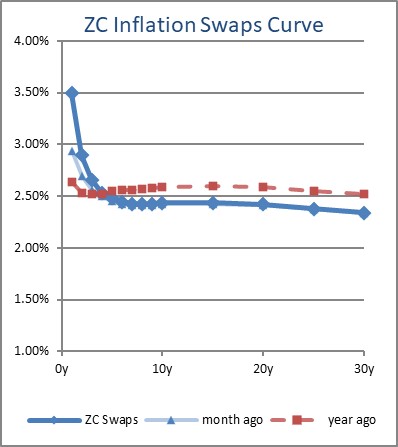
Actually, long-term inflation expectations have been pretty steady, even in the recent market volatility, which is one way that you know that (a) this is a market-price event and not an economy event and (b) there aren’t big liquidity issues out there like we had in the GFC. 10-year inflation breakevens have been between 2.20% and 2.30% over the last week despite the record-breaking series of large equity swings. Anyway, back to CPI.
Some people thought we might see a little hint of the first tariffs in this data. Welp, we didn’t. Headline CPI actually declined – prices fell on average (but wait for it) – by -0.05% m/m and headline inflation is only 2.41% over the last year. More surprising was that core inflation crashed lower, and was only +0.06% m/m to bring the y/y down to 2.81%. That was far below expectations.
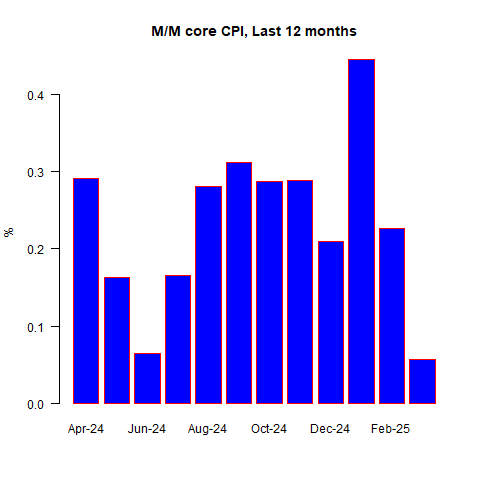
Unfortunately, it’s here I have to tell you to hold your horses. Because when we estimate Median CPI, we don’t get even a whisper of the same effect. In fact, my early estimate has m/m median inflation the highest it has been in about a year. (This month, several regional housing subcategories are clustering around the median so my estimate of +0.35% is subject to being off by a few basis points depending on how the official seasonal adjustment affects the actual m/m increases in those subgroups, but it will not be far from +0.35%).
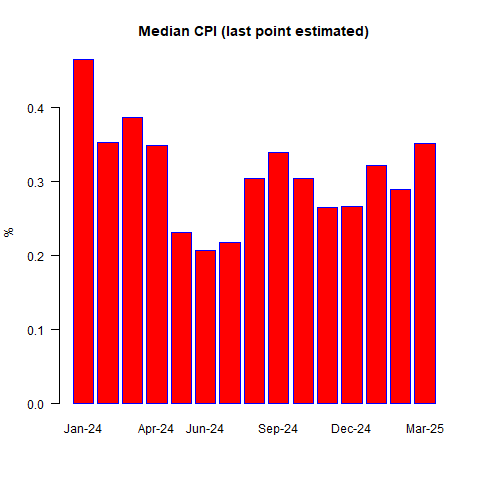
The fact that median doesn’t really show any of the deceleration that core does tells us that this is different from the deceleration last May/June/July, when rents had a brief but temporary lull. In March, Owners’ Equivalent Rent was +0.40% m/m, and Primary Rents +0.33% – both of which are faster than last month’s +0.28%/+0.28%. The y/y numbers are still declining but at a decelerating rate. Still right on schedule, and still zero sign of deflation in housing. Sorry!
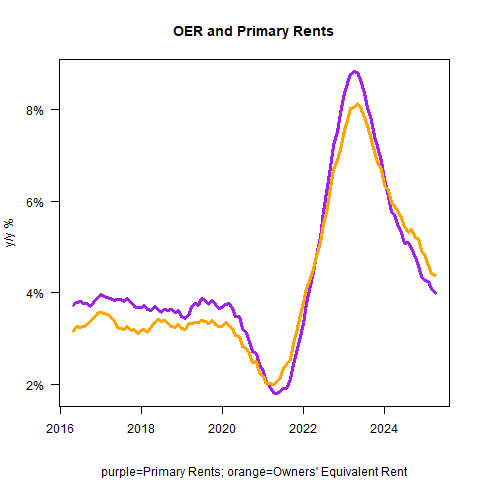
If rents accelerated last month, how did we get a big dip in core but nothing in median? That tells you that we must have gotten large moves in low-weight categories. Which is exactly what happened.
- Medicinal Drugs, -1.30% m/m (last month, +0.18%)
- Used Cars and Trucks, -0.69% (last month +0.88%)
- Airfares, -5.27% m/m (last month -3.99%)
- Lodging Away from Home, -3.54% (last month +0.18%)
- Car and Truck Rental, -2.66% (last month -1.25%)
These are, sadly, most of the ‘usual suspects’ when it comes to surprises in either direction. When they all surprise in the same direction, it means we get a core number that is way off. And that, my friends, is why we look at Median CPI. Of this list, the Used Cars one is the only one that was actually a surprise in the sense that people nowadays pay attention to that subcomponent and the private surveys anticipated an increase. I’ve written previously about what I think is happening in Medicinal Drugs, and even had a podcast episode recently to discuss it (Ep. 137: Drug Prices and the Most-Favored-Nation Clause). This is not going to continue, with 100%+ tariffs on China, where most of our Active Pharmaceutical (TADAWUL:2070) Ingredients come from. I do wonder whether the decline in airfares (more than would be expected from jetfuel prices) and lodging away from home could partly reflect a decline in tourism to the US – both the official kind and the unofficial ‘tourism’ that has been reversing recently with the help of INS – which means it won’t soon be reversed. Not sure on that.
The net effect of these big moves in small categories is that core goods has not yet turned positive (but it will, once the tariffs go into effect, although not by a huge amount) and core services dropped sharply to 3.7% y/y from 4.1% y/y.
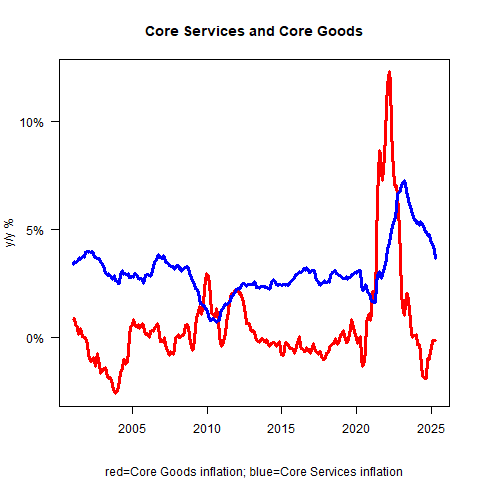
Supercore looks great for the first time in a while. Month/month it fell -0.24%, the sharpest decline since COVID. And the y/y dropped towards 3% as if though it was going to miss the bus if it didn’t get there soon.
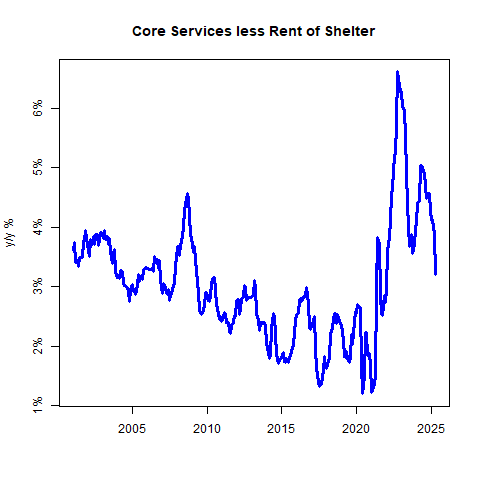
Before we all get excited, I’ll point out that the three spikes on the m/m Supercore chart below were all March and April numbers. I suspect that part of what we are seeing is due to the changing placement of Easter, along with Spring Break…and if so, those parts will be unwound in the next month or two.
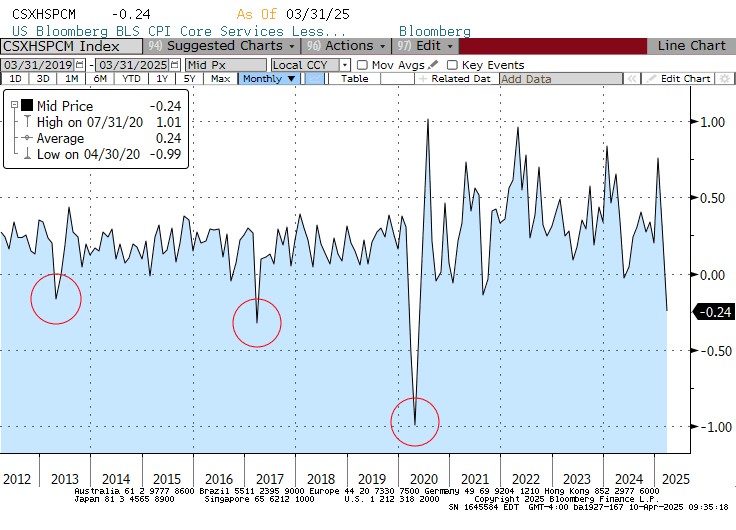
That doesn’t explain the sharp fall in car and truck rental prices. That is a bit of a head scratcher.
There is a little bit of bad news here, but it is away from core. Food Away from Home (which is in supercore) was behaved at +0.36% m/m vs +0.39% m/m last month, but Food at Home was +0.49% seasonally-adjusted compared with +0.01% last month. It wasn’t just Eggs, which rose less than 2% last month at the retail level and are declining at the wholesale level. Milk, Cheese, and Meats/poultry/fish all saw meaningful increases. The proletariat (of which I am one) notices these things, so if we were weighting the index by salience instead of dollars spent they would get a heavy weight. Now, there’s a reason that we take out Food and Energy…the noise generally outweighs the signal. But take administrative note of the small but noticeable acceleration in food prices on a y/y basis.
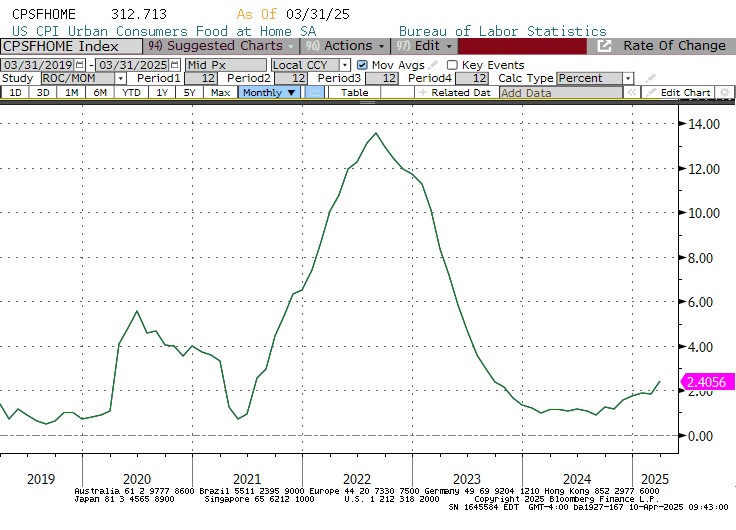
Overall, even though this was the second pleasant Core CPI surprise in a row it was also the second Core CPI surprise that shouldn’t get you very excited. In both cases, the fact that Median CPI will not echo the deceleration tells you that this is happening in the small categories that tend to mean-revert. They didn’t mean-revert this month, but I suspect they will. Unfortunately, that will happen at the same time that 10% broad tariffs, and large tariffs on Chinese goods, are kicking into effect. We might have a whopper of a Core CPI coming up here in one of the next few months.
In the broader picture, inflation is settling in the mid-to-high 3s (measured by Median CPI), but there are clouds on the immediate horizon from tariffs. But as the stability in the longer-term inflation measures suggests, the market isn’t really yet concerned that another upswing is on the way. Tariffs are a one-off effect, and a reasonably small effect overall although significant in the specific categories where they are leveed. Remember, though, that core goods, where the tariffs mainly fall, is only 19.4% of the overall consumption basket.
The longer-term picture depends on how long the uncertainty lasts. As I have pointed out before, economic policy uncertainty – which is off the charts right now – manifests itself in downward pressure on monetary velocity. I expect that the uncertainty will largely be past us in 6 months, and in the meantime the upward pressure on prices from tariffs that shows up in core goods will probably dominate the downward pressure from policy uncertainty (which causes consumers to keep more precautionary savings, causing the velocity decline). Those effects will probably wear off at roughly the same time so that we will only notice it at the micro level.
Uncertainty also, obviously, lowers the price of risky assets (I’ve also written about this!), in a healthy way. But I am not one of those people who worries that uncertainty will have a large effect on the underlying economic activity. Yes, CEOs may delay making big plans for a month or two. But the uncertainty won’t last forever, and then they’ll make their plans. CEOs who can’t make decisions under at least mild uncertainty aren’t going to be CEOs very long. The domestic economy will be just fine, especially as we continue to produce more of our internal consumption needs, domestically.
And for the Fed? The right answer to uncertainty from a policymaker perspective is to increase the hurdle for taking action. The right answer is to make no changes to policy. I am not confident that the Federal Reserve will correctly separate the ‘price of risk’ effect from the ‘economic growth’ effect. They are correct to note that tariffs by themselves are not inflationary in that they are one-off effects. If they believe that, and they think there’s a big recession coming, they’ll cut rates. That would be a mistake, especially given the uncertainty.
